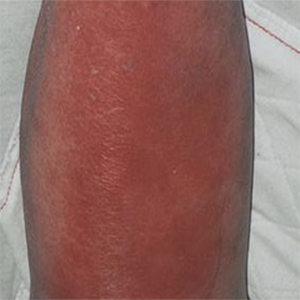The effectiveness of erysipelas prophylaxis depends on the cumulative dose of benzathine penicillin G

HTML: 13
All claims expressed in this article are solely those of the authors and do not necessarily represent those of their affiliated organizations, or those of the publisher, the editors and the reviewers. Any product that may be evaluated in this article or claim that may be made by its manufacturer is not guaranteed or endorsed by the publisher.
Erysipelas is an acute infection due to S. pyogenes and is characterized by a high risk of relapses. The number of patients suffering from one or more recurrences varied depending on the study and accounted for between 16% and 47% of the total number of those affected. Antibiotic prophylaxis with the use of penicillin can reduce the risk of recurrence by 47%. A number of 873 patients with erysipelas treated at the Hospital for Infectious Diseases in Warsaw from 2010 to 2018 was enrolled in the study. Benzathine-penicillin G was given intramuscularly at a dose of 1.2 MU or 2.4 MU or 3.6 MU. The earliest moment that prophylactic treatment was administered was the first episode of erysipelas recurrence. The decision to administer the antibiotic and the dose to use was discretionally made by the examining physician. Altogether 104 (11.9%) persons experienced at least one episode of erysipelas recurrence during the study period. A total of 2976 doses of benzathine- penicillin G (BP) were administered. The most common dose was that of 2.4 MU (2380, 80%). The dose of 1.2 MU was given 567 times (19%). The highest dose, i.e. 3.6 MU, was administered to only 5 patients (8 applications, 0.2%). No effect was shown by either the number of benzathine- penicillin G administered doses (p=0.07) or the median dose (p=0.65), whereas patients without relapse received a statistically higher cumulative dose of the antibiotic (p=0.047). Age was a risk factor of recurrence only in the group of diabetic patients (p=0.03). Benzathine penicillin G given in an appropriate cumulative dose is effective in preventing erysipelas recurrence.
Chlebicki MP, Oh CC. Recurrent Cellulitis: Risk, Factors, Etiology, Pathogenesis and Treatment. Curr Infect Dis Rep 2014;16:422. DOI: https://doi.org/10.1007/s11908-014-0422-0
Kasper DL, Fauci AS. Harrison's Infectious Diseases. 3rd ed. McGraw-Hill Education; 2017.
Leclerc S, Teixeira A, Mahe E, et al. Recurrent Erysipelas: 47 Cases. Dermatology 2007;2014:52-7. DOI: https://doi.org/10.1159/000096913
Rob F, Hercegova J. Benzathine penicillin G once-every-3-week prophylaxis for recurrent erysipelas: a retrospective study of 132 patients. J Dermatolog Treat 2018;29:39-4. DOI: https://doi.org/10.1080/09546634.2017.1329507
Dalal A, Eskin-Schwartz M, Mimouni D et al. Interventions for the prevention of recurrent erysipelas and cellulitis. Cochrane Database Syst Rev 2017;6:CD009758. DOI: https://doi.org/10.1002/14651858.CD009758.pub2
Oh CC, Hung Ko HC, Lee HY, et al. Antibiotic prophylaxis for preventing recurrent cellulitis: a systematic review and meta-analysis. J Infect 2014;69:26-34. DOI: https://doi.org/10.1016/j.jinf.2014.02.011
U.K Dermatology Clinical Trials Network's PATCH Trial Team. Prophylactic antibiotics for the prevention of cellulitis (erysipelas) of the leg: results of the U.K. Dermatology Clinical Trials Network’s PATCH II trial. Br J Dermatol 2012;166:169–78. DOI: https://doi.org/10.1111/j.1365-2133.2011.10586.x
Jorup-Ronstrom C, Britton S. Recurrent erysipelas: predisposing factors and costs of prophylaxis. Infection 1987:15:105-6. DOI: https://doi.org/10.1007/BF01650206
Bartholomeeusen S, Vandenbroucke J, Truyers C, et al. Epidemiology and comorbidity of erysipelas in primary care. Dermatology 2007;215:118-22. DOI: https://doi.org/10.1159/000104262
Vignes S, Dupuy A. Recurrence of lymphoedema‐associated cellulitis (erysipelas) under prophylactic antibiotherapy: a retrospective cohort study. JEADV 2006;20:818-22. DOI: https://doi.org/10.1111/j.1468-3083.2006.01648.x
Thomas KS, Crook AM, Nunn AJ, et al. Penicillin to prevent recurrent leg cellulitis. N Engl J Med 2013;368:1695-703. DOI: https://doi.org/10.1056/NEJMoa1206300
Chen HM, Li YL, Liu YM, et al. The experience of intramuscular benzathine penicillin for prophylaxis of recurrent cellulitis: A cohort study. J Microbiol Immunol Infect 2017;50:613-8. DOI: https://doi.org/10.1016/j.jmii.2015.08.008
Neely M, Kaplan EL, Blumer JL, et al. A Population Pharmacokinetic Modeling Approach Shows that Serum Penicillin G Concentrations Are Below Inhibitory Concentrations by Two Weeks after Benzathine Penicillin G Injection in the Majority of Young Adults. Antimicrob Agents Chemother 2014;58:6735–41. DOI: https://doi.org/10.1128/AAC.02744-14
Passali D, Lauriello M, Passali GC, et al. Group A Streptococcus and its antibiotic resistance. Acta otorhinolaryngologica italica 2007;27:27-32
Stevens DL, Bryant AE. Impetigo, Erysipelas and Cellulitis. In: Ferretti JJ, Stevens DL, Fischetti VA, editors. Streptococcus pyogenes: Basic Biology to Clinical Manifestations [Internet].Oklahoma City (OK): University of Oklahoma Health Sciences Center; 2016.
Brishkoska-Boshkovski V, Kondova-opuzovska I, Damevska K et al. Comorbidities as Risk Factors for Acute and Recurrent Erysipelas. Open Access Macedon J Med Sci 2019;7:937-42. DOI: https://doi.org/10.3889/oamjms.2019.214
Koster JB, Kulberg BJ, van der Meer JWM. Recurrent erysipelas despite antibiotic prophylaxis: an analysis from case studies. Neth J Med 2007;65:89-94.
Ustawa z dnia 16 listopada 2016 r. o zmianie ustawy o emeryturach i rentach z Funduszu Ubezpieczeń Społecznych oraz niektórych innych ustaw.
Carey IM, Critchley JA, DeWilde S, et al. Risk of Infection in Type 1 and Type 2 Diabetes Compared with the General Population: A Matched Cohort Study. Diabetes Care 2018;41:513-21. DOI: https://doi.org/10.2337/dc17-2131
Supporting Agencies
The study was supported by Fundacja Rozwoju Nauki w Wojewódzkim Szpitalu Zakaźnym (Foundation for the Development of Infectious Diseases at the Voivodship Infectious Diseases Hospital) through financial support for data collection and article publishing charge.PAGEPress has chosen to apply the Creative Commons Attribution NonCommercial 4.0 International License (CC BY-NC 4.0) to all manuscripts to be published.





 https://doi.org/10.4081/dr.2022.9429
https://doi.org/10.4081/dr.2022.9429



